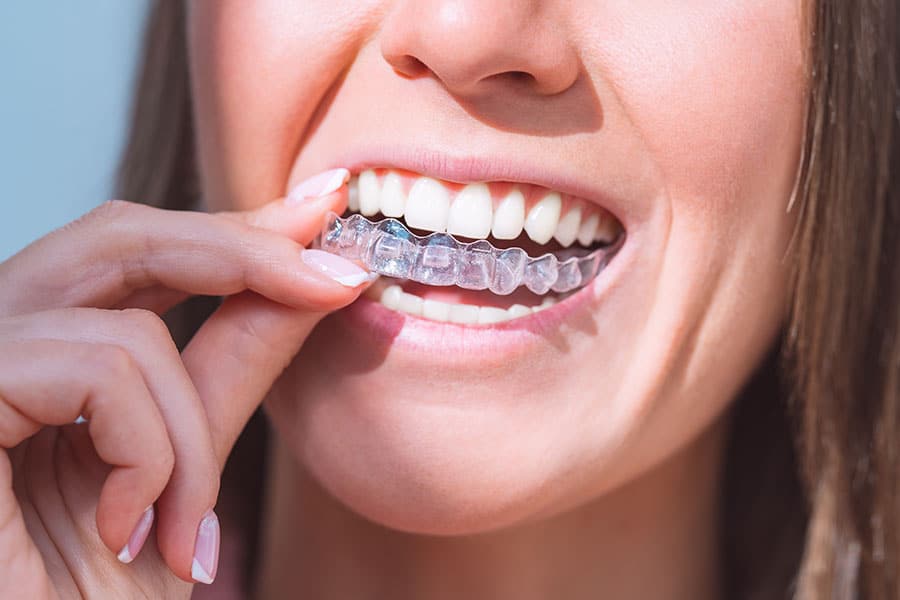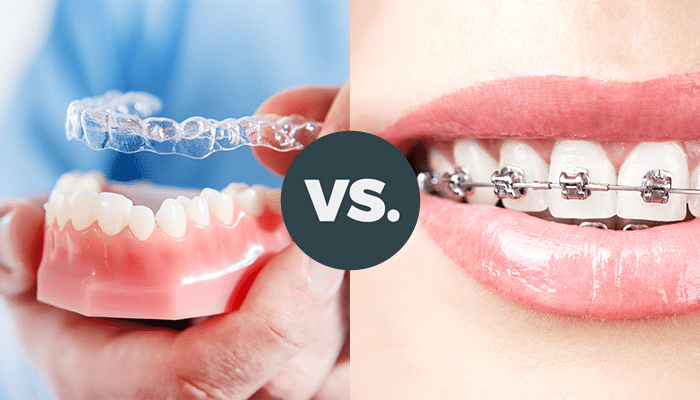In recent years, there has been a significant shift towards using invisible aligners as an alternative to traditional braces. These clear orthodontic devices have gained popularity due to their effectiveness and aesthetic appeal. In this article, I will explore the advantages of using invisible aligners, their suitability for different individuals, and the cost and insurance coverage associated with this orthodontic treatment.
Advantages of using invisible aligners
One of the key advantages of invisible aligners is their discreet appearance. Unlike traditional braces, which use metal brackets and wires, invisible aligners are made from a clear plastic or acrylic material that is virtually invisible when worn. This makes them an attractive option for individuals who may be self-conscious about their appearance during orthodontic treatment.
Another advantage of invisible aligners is their removability. Unlike braces, which are fixed appliances, aligners can be easily taken out when eating, brushing, and flossing. This not only makes oral hygiene maintenance more convenient but also allows individuals to enjoy their favorite foods without restrictions.
However, it is important to note that aligners should be worn for the recommended amount of time each day to ensure the effectiveness of the treatment.
Suitability of invisible aligners
Invisible aligners are typically used for patients with mild to moderate teeth crowding or spacing issues. They are not typically recommended for individuals with severe orthodontic problems or complex bite issues. Before undergoing treatment with invisible aligners, it is important to consult with a dentist or orthodontist who can evaluate your specific case and determine if aligners are the right choice for you.
Cost and insurance coverage
The cost of invisible aligner treatment can vary depending on factors such as the complexity of the case and the duration of treatment. In general, treatment with invisible aligners is more expensive than traditional braces. On average, the cost of aligner treatment ranges from $5,000 to $6,000, whereas traditional braces cost around $5,300 for adolescents and $5,600 for adults. It is worth noting that these prices are not set in stone and can vary based on the individual provider.
Insurance coverage for invisible aligners may vary depending on the insurance plan. Some insurance companies do provide coverage for orthodontic treatment, including aligners, up to a certain limit. It is recommended to check with your insurance provider to understand the extent of coverage and any limitations or requirements that may apply.
Innovations in Modern Orthodontic Techniques
Advancements in technology have revolutionized the field of orthodontics, leading to the development of innovative treatment options. In this section, I will compare two popular invisible aligner brands, Invisalign and Byte, and discuss the impact of technology on orthodontic treatment as well as the accessibility of orthodontic care.
Invisalign vs. Byte: A comparative analysis
Invisalign and Byte are two well-known brands in the realm of invisible aligners. Both brands offer clear aligners that are custom-made for each individual’s teeth.
However, there are some differences between the two.
Invisalign is the largest producer of clear aligners and has been in the market for a longer period of time. They have established themselves as a trusted brand and have a wide network of dentists and orthodontists who provide Invisalign treatment. Invisalign aligners are made from a patented SmartTrack material, which provides a comfortable fit and predictable tooth movement.
Byte, on the other hand, is a relatively newer brand that has gained popularity for its fast treatment options. Byte offers two types of aligner plans: all-day clear aligners and at-night clear aligners. The all-day aligner plan includes a device called HyperByte, which uses high-frequency vibration to speed up the aligner treatment process. Byte also provides a premium aligner material and personalized treatment plans approved by licensed dentists or orthodontists.
Impact of technology on orthodontic treatment
Technological advancements have greatly enhanced the precision and efficiency of orthodontic treatment. Digital scanning technologies, such as intraoral scanners, have replaced traditional impressions, making the process more comfortable and accurate. These scanners capture detailed 3D images of the teeth, which serve as the basis for designing custom aligners.
Additionally, computer-aided design and manufacturing (CAD/CAM) software has revolutionized the production of aligners. This technology allows for the precise design and fabrication of aligners, ensuring a perfect fit for each individual’s teeth. CAD/CAM technology also enables orthodontists to simulate the movement of teeth throughout the treatment process, providing a visual representation of the expected results.
Orthodontic care accessibility
The advent of invisible aligners and advancements in technology have made orthodontic care more accessible to a wider audience. Traditional braces often require frequent in-person visits to the orthodontist for adjustments, which may be inconvenient for individuals with busy schedules or limited access to orthodontic clinics.
In contrast, invisible aligners offer the convenience of remote treatment monitoring through the use of smartphone apps and virtual check-ins.
Virtual consultations and teledentistry have also emerged as popular options for orthodontic care. These remote services allow individuals to receive orthodontic advice, treatment planning, and progress monitoring from the comfort of their own homes. This can be particularly beneficial for individuals who live in rural areas or have transportation limitations.
Consumer Perspective and Experience with Invisible Aligners
Real-life testimonials and experiences play a crucial role in shaping the perception of invisible aligners. In this section, I will explore the impact of social media influence and endorsements, as well as the long-term satisfaction and follow-up care associated with invisible aligners.
Real-life testimonials and experiences
Social media platforms have become a hub for individuals to share their experiences with various products and services, including invisible aligners. Many users take to platforms like Instagram, YouTube, and TikTok to document their orthodontic journey, showcasing their progress and sharing their thoughts on the treatment process.
These real-life testimonials can provide valuable insights into the effectiveness and experience of using invisible aligners. By hearing firsthand accounts from individuals who have undergone aligner treatment, prospective patients can gain a better understanding of what to expect and make an informed decision.
Social media influence and endorsements
In recent years, social media influencers have played a significant role in promoting invisible aligners. Influencers with a large following often partner with aligner brands to share their experiences and endorse the product. While these endorsements can raise awareness and generate interest, it is important for consumers to approach them with a critical mindset and consider multiple sources of information.
It is advisable to seek out reviews and testimonials from a variety of individuals, including those who are not affiliated with aligner brands. This will provide a more balanced perspective and help form a well-rounded understanding of the treatment.
Long-term satisfaction and follow-up care
The satisfaction of patients with invisible aligners is not limited to the duration of the treatment. Long-term follow-up care plays a crucial role in ensuring the stability and maintenance of the results achieved through orthodontic treatment. After completing the aligner treatment, individuals are often provided with retainers that help keep their teeth in their new position.
It is important for individuals to diligently follow the instructions provided by their dentist or orthodontist regarding retainer wear. Failure to wear retainers as prescribed can lead to a relapse, where the teeth gradually shift back to their original position. Regular follow-up appointments with the orthodontic provider are also necessary to monitor the long-term stability of the results and address any concerns that may arise.
Future Trends and Developments in Orthodontic Practices
As the field of orthodontics continues to evolve, new trends and developments are shaping the future of orthodontic practices. In this section, I will discuss evolving technologies in orthodontics, the integration of orthodontics and digital healthcare, and the shift towards personalized orthodontic solutions.
Evolving technologies in orthodontics
Technological advancements continue to drive innovation in the field of orthodontics. One notable development is the use of 3D printing technology to create dental aligners. 3D printing allows for the precise fabrication of aligners, reducing production time and increasing cost-effectiveness. This technology has the potential to further improve the accessibility and affordability of orthodontic treatment.
Another emerging technology is the use of augmented reality (AR) and virtual reality (VR) in orthodontics. These immersive technologies can simulate the outcome of orthodontic treatment, allowing patients to visualize the final results before committing to a treatment plan. AR and VR can also be used to educate patients about oral hygiene practices and create an engaging and interactive patient experience.
Integration of orthodontics and digital healthcare
The integration of orthodontics with digital healthcare platforms is another trend that is gaining momentum. Teleorthodontics, which involves remote monitoring and treatment planning, allows orthodontists to provide care to patients who may not have direct access to orthodontic clinics. This approach leverages technology to streamline communication between patients and orthodontic providers, improving efficiency and convenience.
Digital healthcare platforms can also facilitate personalized treatment planning by utilizing artificial intelligence (AI) algorithms. AI algorithms can analyze data from patients’ dental scans and digital records to create customized treatment plans tailored to their specific needs. This personalized approach can maximize treatment effectiveness and minimize the duration of orthodontic treatment.
Shift towards personalized orthodontic solutions
One-size-fits-all approaches are being gradually replaced by personalized orthodontic solutions. Advances in technology and data analytics enable orthodontists to gain a deeper understanding of patients’ unique dental characteristics and treatment needs. This allows for the customization of treatment plans that are specifically tailored to address individual concerns and achieve optimal results.
Personalized orthodontic solutions can encompass various aspects, including treatment duration, force application, and treatment goals. By taking into account factors such as age, severity of the orthodontic problem, and patient preferences, orthodontists can deliver more efficient and effective treatment outcomes.
FAQs
Here are some frequently asked questions about invisible aligners:
What are invisible aligners?
Invisible aligners are clear orthodontic devices that are used to straighten teeth. They are made from a clear plastic or acrylic material and are custom-made for each individual’s teeth.
How do aligners work?
Aligners work by exerting gentle pressure on the teeth, gradually moving them into the desired position. Each set of aligners is worn for a specific duration, typically a few weeks, before progressing to the next set.
What are the benefits of using aligners?
The benefits of using aligners include their discreet appearance, removability for eating and oral hygiene, and the ability to avoid the dietary restrictions associated with traditional braces.
How long do I need to wear the aligners each day?
Aligners should be worn for the recommended amount of time each day, which is typically 20 to 22 hours. They can be removed for eating, brushing, and flossing.
In conclusion, invisible aligners offer a promising alternative to traditional braces, providing effective orthodontic treatment with enhanced aesthetic appeal. With advancements in technology and personalized treatment options, the future of orthodontics looks promising. It is important for individuals considering aligner treatment to consult with a dental professional to determine their suitability and explore the available options.



